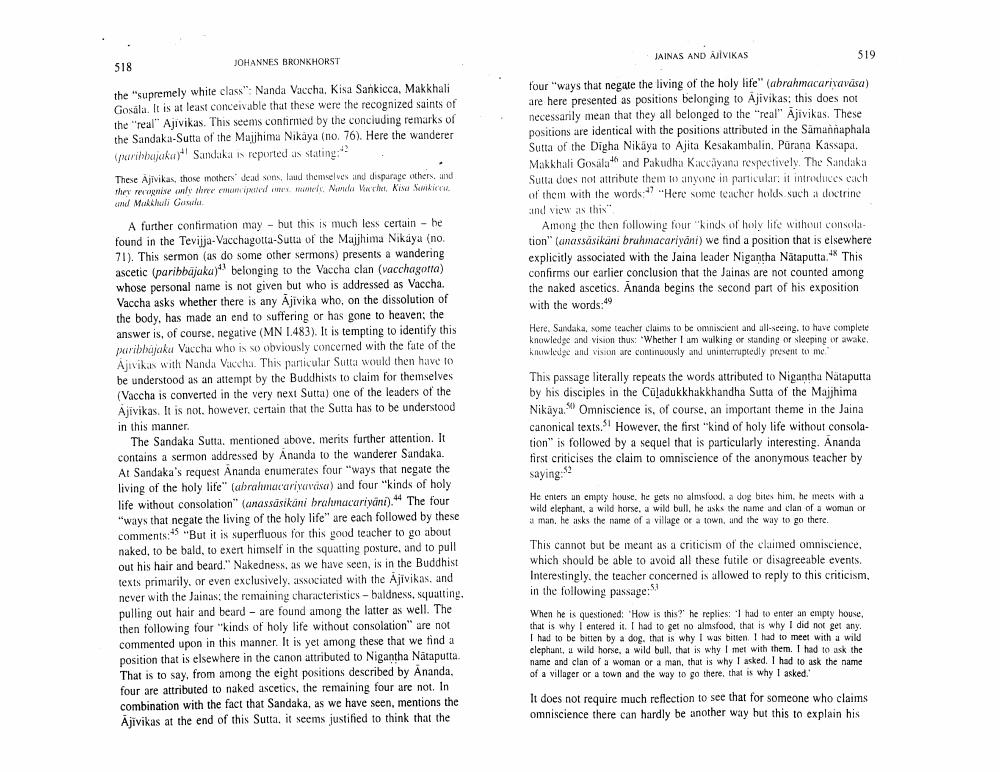Book Title: Riddle Of Jainas And Ajivikas In Early Buddhist Literature Author(s): Johannes Bronkhorst Publisher: Johannes Bronkhorst View full book textPage 5
________________ 518 JOHANNES BRONKHORST the "supremely white class": Nanda Vaccha, Kisa Sankicca, Makkhali Gosala. It is at least conceivable that these were the recognized saints of the "real" Ajivikas. This seems confirmed by the concluding remarks of the Sandaka-Sutta of the Majjhima Nikaya (no. 76). Here the wanderer (paribhajaka) Sandaka is reported as stating:42 These Ajivikas, those mothers' dead sons, laud themselves and disparage others, and they recognise only three emancipated ones namely, Nanda Veche, Kisa Sankiccu and Makkhuli Gasda. A further confirmation may but this is much less certain - he found in the Tevijja-Vacchagotta-Sutta of the Majjhima Nikaya (no. 71). This sermon (as do some other sermons) presents a wandering ascetic (paribbājaka) belonging to the Vaccha clan (vacchagotta) whose personal name is not given but who is addressed as Vaccha. Vaccha asks whether there is any Ajivika who, on the dissolution of the body, has made an end to suffering or has gone to heaven; the answer is, of course, negative (MN 1.483). It is tempting to identify this paribbajaku Vaccha who is so obviously concerned with the fate of the Ajivikas with Nanda Vaccha. This particular Sutta would then have to be understood as an attempt by the Buddhists to claim for themselves (Vaccha is converted in the very next Sutta) one of the leaders of the Ajivikas. It is not, however, certain that the Sutta has to be understood - in this manner. The Sandaka Sutta, mentioned above, merits further attention. It contains a sermon addressed by Ananda to the wanderer Sandaka. At Sandaka's request Ananda enumerates four "ways that negate the living of the holy life" (abrahmacariyavasa) and four "kinds of holy life without consolation" (anassäsikäni brahmacariyani).44 The four "ways that negate the living of the holy life" are each followed by these comments: "But it is superfluous for this good teacher to go about naked, to be bald, to exert himself in the squatting posture, and to pull out his hair and beard." Nakedness, as we have seen, is in the Buddhist texts primarily, or even exclusively, associated with the Ajivikas, and never with the Jainas; the remaining characteristics - baldness, squatting. pulling out hair and beard are found among the latter as well. The then following four "kinds of holy life without consolation" are not commented upon in this manner. It is yet among these that we find a position that is elsewhere in the canon attributed to Nigantha Nataputta. That is to say, from among the eight positions described by Ananda. four are attributed to naked ascetics, the remaining four are not. In combination with the fact that Sandaka, as we have seen, mentions the Ajivikas at the end of this Sutta. it seems justified to think that the 519 JAINAS AND AJIVIKAS four "ways that negate the living of the holy life" (abrahmacarivavāsa) are here presented as positions belonging to Ajivikas: this does not necessarily mean that they all belonged to the "real" Ajivikas. These positions are identical with the positions attributed in the Samannaphala Sutta of the Digha Nikaya to Ajita Kesakambalin. Purana Kassapa. Makkhali Gosala and Pakudha Kaccayana respectively. The Sandaka Sutta does not attribute them to anyone in particular: it introduces each of them with the words: "Here some teacher holds such a doctrine and view as this" Among the then following four "kinds of holy life without consolation" (anassäsikäni brahmacariyani) we find a position that is elsewhere explicitly associated with the Jaina leader Nigantha Nataputta." This confirms our earlier conclusion that the Jainas are not counted among the naked ascetics. Ananda begins the second part of his exposition with the words:49 Here, Sandaka, some teacher claims to be omniscient and all-seeing, to have complete knowledge and vision thus: "Whether I am walking or standing or sleeping or awake. knowledge and vision are continuously and uninterruptedly present to me This passage literally repeats the words attributed to Nigantha Nätaputta by his disciples in the Culadukkhakkhandha Sutta of the Majjhima Nikaya. Omniscience is, of course, an important theme in the Jaina canonical texts. However, the first "kind of holy life without consolation" is followed by a sequel that is particularly interesting. Ananda first criticises the claim to omniscience of the anonymous teacher by saying: He enters an empty house, he gets no almsfood, a dog bites him, he meets with a wild elephant, a wild horse, a wild bull, he asks the name and clan of a woman or a man, he asks the name of a village or a town, and the way to go there. This cannot but be meant as a criticism of the claimed omniscience, which should be able to avoid all these futile or disagreeable events. Interestingly, the teacher concerned is allowed to reply to this criticism, in the following passage: When he is questioned: 'How is this? he replies: I had to enter an empty house, that is why I entered it. I had to get no almsfood, that is why I did not get any. I had to be bitten by a dog, that is why I was bitten. I had to meet with a wild elephant, a wild horse, a wild bull, that is why I met with them. I had to ask the name and clan of a woman or a man, that is why I asked. I had to ask the name of a villager or a town and the way to go there, that is why I asked." It does not require much reflection to see that for someone who claims omniscience there can hardly be another way but this to explain hisPage Navigation
1 ... 3 4 5 6 7 8 9 10
